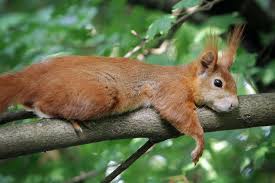Did you ever wonder how animals beat the heat?
The other day I was wondering as I dripped while walking two very hot dogs…”How do wild critters do it?’ I was so hot, but I was headed home to air conditioning and a cold ‘one’!
Nature is full of surprises! I found out more about the many adaptations wildlife, in our area, use to survive these sweltering days of summer!
Shedding. Since being covered with body fur is a characteristic of mammals it makes good sense to have a way to lighten the coat for summer wear. Once spring comes around, hormones in the body cause these dense coats to fall out gradually, sometimes in large patches, until a lighter summer coat is in place. A white-tailed deer’s summer coat is a reddish color to blend in with the new green growth.
Radiating heat from the body. Some species, such as rabbits, mice, chipmunks, squirrels, bats, foxes, coyotes, and deer lose heat through their ears which they hold up and out from their bodies. The blood flowing into the ears carries heat with it, and the thin skin on the inside of the ears enables the heat to dissipate out at a fairly rapid rate. The cooled blood then flows back into the body’s bloodstream and helps to reduce the heat’s adverse effects on other body systems.
Panting. We have all seen dogs and even cats pant when they are stressed from high temperatures, and breathing rapidly (panting) helps the body rid itself of excess heat. If we think back to the cold days of winter, we know that when we breathe out into the cold we can see our breath in small clouds because it is hot in the frigid air. Many species of animals get rid of excess body heat by panting. Perhaps you have even noticed birds in the summer walking around or perching with their beaks open — they are panting when they do this. The air sacs in their high-functioning respiratory systems help the lungs, through panting, to rid their bodies of excess heat in much the same way as in other animals.
Hiding. Just as we do, many animals seek out shelter during the heat of the day. Since cold-blooded species are unable to regulate their own body temperatures, they must depend on the air temperature around them to provide the warmth their bodies need. But when the hot summer sun beats down intensely, these species are very susceptible to physiological damage from so much heat. Reptiles (especially snakes and lizards) are sensitive to this and in fact can die after only a few hours’ exposure to the summer sun. Their task on sweltering days is to hide out under rocks or fallen logs, or in underground burrows until the environment cools. Amphibians such as toads and salamanders will burrow under leaf litter and stay in shady protected areas. Frogs will burrow into the mud or linger in the coolness of the water, while aquatic turtles and freshwater fish go into cooler, deeper water during heat waves. Entire populations of these animals can be affected if the heat goes on too long, as they are unable to feed and breed adequately if so much time is spent hiding from the sun. And one of the best ways to cool down for mammals (in their furry coats) is to seek out shade and remain inactive when heat waves hit.
Sweating. Some animals have the ability to sweat just as people do, the horse being a perfect example. Sweating wets the skin, and the evaporation of that moisture helps to cool the body, making the animal more comfortable and helping it to regulate its body temperature. Species in the canine and feline families have some sweat glands in the bottoms of their feet, but that is a minor help at best as it is not a large enough surface area to cool the entire body completely. So what do these animals do? They employ other methods for cooling such as panting and shade-seeking, and drinking plenty of water.
Water. There are many species of wildlife that benefit greatly from taking a dip to cool off. If you provide water for backyard wildlife, then it is most likely a welcome oasis for these creatures in hot weather. Toads, frogs, salamanders, and turtles will often benefit from simple water receptacles set at ground level, and birds in particular enjoy taking baths in a simple bird bath set up in the yard. Not only does it help them to cool off, but water helps to hydrate the skin of amphibians. It cleans the birds’ feathers so that they remain in peak condition for flying and for insulation from the heat. And of course, we must not overlook the importance of water for drinking, as animals of all types must keep themselves hydrated so that their body systems continue to run efficiently.
One, of the best ways to wildlife watch and provide resources to our wildlife in Lake Zurich is to put out a simple birdbath. Ours, is so simple that every morning I just add a fresh pitcher of cool water. Within ½ hour our hummingbird family shows up! Two weeks ago I had a small flock of Cedar Waxwings create havoc as their enjoyed a communal dip! While summertime is a wonderful season to be outside and enjoy the beauty of the natural world, it has its challenges for nature’s creatures, there’s no doubt about it.
Adapted from an article by Ester Lutz, University of Illinois Extension, Coles County Illinois
Til next time!
Mary Kozub
AOF Board Member
Mary has worked for McHenry County Conservation District for 16 years and has been a “founding” member of the Village of Lake Zurich’s Tree Commission for 20 years.


